Vol. 42, #1, Spring 2024
New Insights from the Tucson Gem Shows 2024, Gem News, Gemstone Charts (1975-2023), Brief Analysis of Gemstone Forecaster Prices (1975-2023)
- Home
- Newsletter
- Vol. 42, #1, Spring 2024
New Insights from the Tucson Gem Shows 2024, Gem News, Gemstone Charts (1975-2023), Brief Analysis of Gemstone Forecaster Prices (1975-2023)
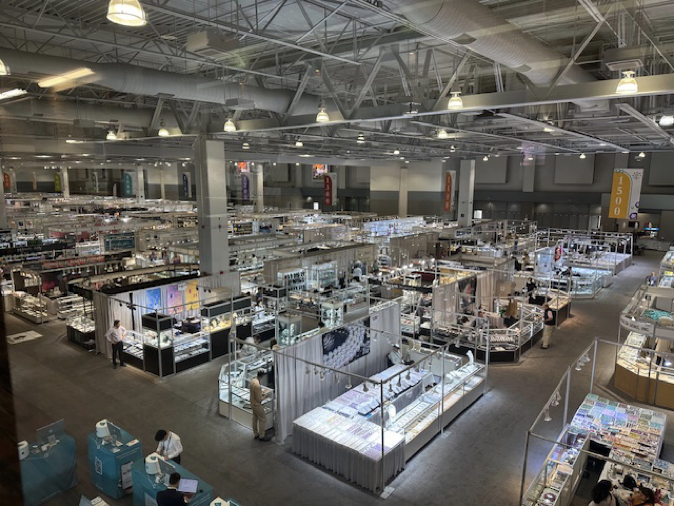
Prices have jettisoned higher again at the high end Tucson Gem Shows. We know these new prices reflect a fast moving upward market. We saw dealers buying at high prices and immediately reselling top stones to clients on their phones. We saw retail jewelers buying for inventory or special clients. We are shocked at just how much money is out there worldwide. Perhaps because of rising stock markets and/or inflation, people have a great deal of money to spend. Because of inflation, collectors want a portion of their portfolios in top gems to diversify their other investments. Another interesting possibility is that the show has become more well known because certain dealers live stream on social media. Has the show become too well known, too famous? Some dealers swear never to return and are thinking other international shows represent much better value. It's getting harder and harder to find really good deals at Tucson. You must search diligently. The days of waiting until the last day to make a low offer and score a great deal are no longer. Instead you find yourself competing with other dealers and when you go back to check on a stone you were interested in, it's often already gone. Also, Tucson was always the place to buy crystals, but these have risen to insane prices as well. One large specimen crystal buyer told us what used to be $5,000 is now $50,000. He said he needed $2.7 million to buy what he wanted at the Shows. The sellers tell you the new prices unflinchingly and don't even entertain lower offers.
The bottom line is prices are dramatically higher than last year. GemGuide, often seen as the definitive source of wholesale prices, really needs some updating work. They recently updated Burma ruby, but need to focus their attention on Burma sapphire, Burma spinel, and Paraiba.
Paraiba Tourmaline
As usual, we chased Paraiba or Paraiba Type Tourmaline. Brazilian and the Nigerian materials are impossible to obtain unless old collectors want to sell. You can forget new production. There is some Mozambique material but you have to be very careful. Many of the gems that were unsalable in the old days are now being treated with polymers to improve clarity. If you have a good eye, these stones are obvious because they have a hazy look, almost like fracture-filled Colombian emeralds. Stay away from these gems unless you get a no clarity enhancement form the AGL.
Here are a few examples of stones we saw at the shows:
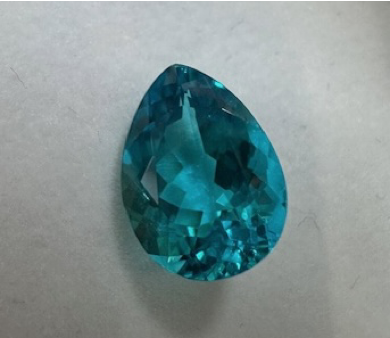 |
|
2.97 low heat Brazilian blue Paraiba |
A beautiful clean Brazilian stone. We were shocked at the wholesale price pushing $100,000 per carat. We thought it would never sell. After all, GemGuide had the best 10 (upper extra fine) quality at $60,000 per carat. It sold way over GemGuide numbers and was immediately resold to a collector. The gem had an AGL Origin Report.
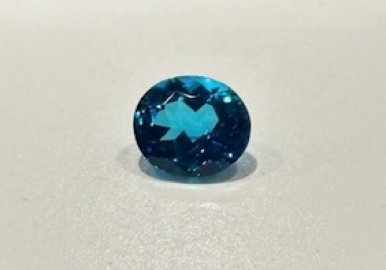 |
|
2.50 no heat Brazilian blue Paraiba |
The stone had a European lab we had never heard of stating no heat, so who really knows? The ask of the stone was $250,000 per carat. Yes, you read the right. Over 1/2 million dollars for a two carat stone.
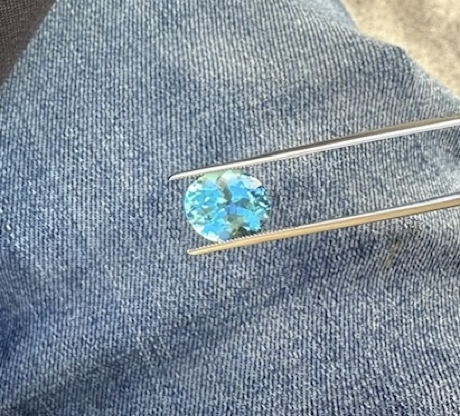 |
|
5 carat Mozambique Paraiba |
Generally speaking the Mozambique material is not as pure blue as some of the Brazilian material. However, that doesn't mean the Mozambique is not beautiful, because it is. A serious dealer made the argument the Mozambique material is actually better than the Brazilian because it looks better mounted, and does not black out. Good point. This stone was for sale for about $150,000. As you can see these stones are still selling for a discount to the Brazilian material. Will this last forever? The market will answer this question eventually.
Lagoon Tourmalines
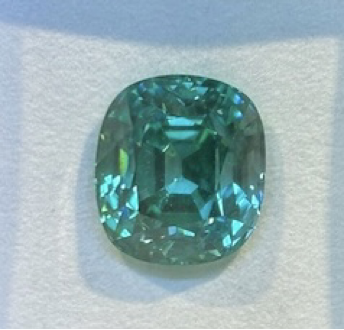 |
|
20+ carat Lagoon tourmaline |
We finally got our eyes on some new "Lagoon" Tourmaline. It's a relatively new discovery from Africa. Being marketed as a Paraiba substitute, it might be an interesting speculation? Originally found in a small pocket of blue stones, those are gone and now only the greenish stones are somewhat available. The dealers say the stones are not heated, but we will need confirmation from the labs on this issue. It might get low heat at AGL, like Paraibas often do. Good news is the top material is a couple of thousand of dollars per carat. Not as pretty as the copper-containing Paraibas but those who buy first often reap the rewards later.
Burma Gems
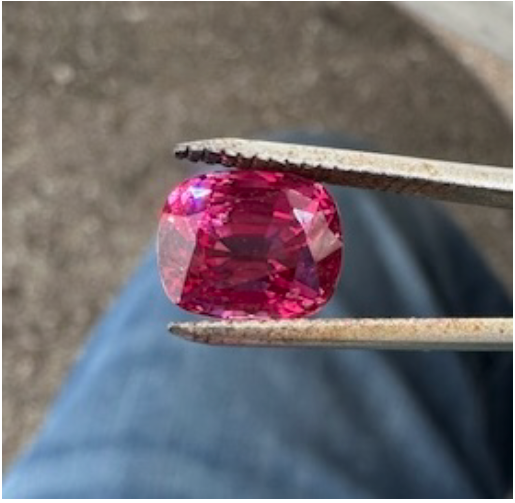 |
|
4 carat Day Glow Burma Spinel |
The amount of no heat Burma stones remains minuscule. Most of the ruby dealers are marketing Mozambique stones and the prices are no longer cheap. Guess they are thinking the Burmese gems are so expensive, why not increase our prices because at least we have availability. There were no Burmese dealer booths in Tucson. Our favorite Burmese pocket dealer didn't even come because he had no material after just returning from Burma. There were some NY dealers with Burmese goods, but they ask tip top dollar to part with their stones.
We saw a major Burmese spinel dealer in Tucson with primarily small (under a carat) gems. His gem-red carat sized spinels were $5000-$10,000 per carat (depending on LI or MI clarity).
We had a long conversation with a Thai dealer that still goes to Burma. It appears the Chinese are no longer the main culprit behind the rising Burmese prices. Due to their economy collapsing, they are no longer buying gems due to their own financial stress with crashing real estate prices and the weak stock market. Yes, Burma is also under tremendous military pressure with an ongoing civil war. Just what is the real issue? Seems like the problem is the Burmese dealers themselves. In a way, they are victims of their own success. In the old days, they needed to sell to finance more exploration and feed their families. Business was so good for so long, with the whole world wanting Burmese stones, these dealers are now extremely rich. Unlike in the West, they have very few options for what to do with their money. They don't trust the kyat, the local Burmese currency. They don't trust banks or their fledgling stock market. So they buy real estate and gems. In their minds, there's no better place to store your money. When dealers go to Burma, whether Burmese or not, the dealers want a higher price than the world market is willing to pay. It's almost like an old Western gun standoff. So far, neither side has blinked and the world has no new Burmese goods. The only way to get top Burmese gems today at prices that are not insanely high is to rebuy from old collectors or estates.
Summary
Nothing seems to be able to stop these gem markets. Despite recessionary fears and higher food/gas prices, this market keeps rolling upwards. Many exhibitors were apprehensive about this year's show, but it turns out their fears were unfounded. Tucson boomed. Some other publications are reporting just an OK show. We totally disagree at the collector level.
U.S. consumers will spend a record $6.4 billion on jewelry around Valentine's Day this year, according to Ankur Daga, founder and CEO of fine jewelry e-commerce company Angara.
A decade ago, about 5% of engagement rings were colored gemstones, according to Daga. Now, it's more than 15%.
The shift toward colored gemstones could be a product of the rise in lab-grown diamonds or a reflection of the customer who wants a more distinctive ring.
Roses are red, violets are blue, gemstones are hot and prices are too.
Valentine's Day has long been one of the most popular days of the year for jewelry and engagements. U.S. consumers will spend a record $6.4 billion on jewelry around Valentine's Day this year, representing 10% of the total annual spend, according to Ankur Daga, founder and CEO of fine jewelry e-commerce company Angara.
This year, the contents of those ring boxes may look a little different from the traditional, natural diamond solitaire.
"We're seeing a shift in much larger center stone engagement rings, primarily as a result of lab-grown diamonds, and sapphires and rubies tend to be very hot," Daga said.
A decade ago, about 5% of engagement rings were colored gemstones, according to Daga. Now, it's more than 15%.
More than 20% of people would upgrade their engagement ring to a colored gemstone — such as an emerald, yellow diamond or pink sapphire, for example — if they could, Daga said, citing results of a survey Angara commissioned of more than 2,000 people.
Industry giant Signet Jewelers is seeing the same gemstone trend in the wedding category as well as in fashion pieces. It's seeing particular pickup in sapphire, morganite, London Blue Topaz, aquamarine and green quartz stones, according to Signet, which sells jewelry under brand banners including Zales, Jared and Kay.
Beyond engagement rings, Signet said amethyst and ruby are always popular stones for the Valentine's season. Amethyst is the birthstone for February, and ruby red evokes the color of love.
But the shift toward colored gemstones could also be a reflection of the customer who wants a "more distinctive piece," said Brilliant Earth CEO Beth Gerstein. The company, which specializes in lab-grown diamonds, also offers gemstones that span the color spectrum.
"We also see gemstones resonating because people love the personalized approach of birthstones," Gerstein said, adding that gemstones, in general, "cater well to a Gen Z audience, as we know they want something that is unique to them and reflective of their personal style."
Supply pressures
Demand for gemstones is increasing just as supply of many natural gemstones is getting tighter.
Rubies and select exotic stones have become more expensive and difficult to source due to quality concerns and limits on the regions that stones can be sourced from. Those challenges have given rise to lookalike stones such as garnet in place of rubies, for example.
"There's only really one mine in Madagascar that produces the bulk of the world's rubies," said Daga of Angara. "If we look at sapphire, Burmese and Kashmir mines are now shut so you really have Sri Lanka and Madagascar as the two primary providers. Even on the emerald side, we see that Zambia and Colombian emerald supply is much harder to come by, at much higher prices, than in the past."
Wholesale prices for sapphire gemstones are up 12% per year over the past three years, Daga said. For emeralds, its 13%, and rubies, 17%.
"Some of the more niche stones, like pearls and opals, are up over 20% a year. Tourmalines are up all the way up to 36% a year," he said.
By comparison, the compound annual growth rate of the S&P 500 stock index is 10.5% over the past three years.
Daga argues the shift in supply and demand of gemstones — and consumers' general desire for color in many luxury goods, such as gemstone bezels on Rolex watches or brightly colored Ferraris — makes the stones a more attractive asset class.
"If you look at Bonhams, Sotheby's and Christie's auctions very recently, over half of the gemstone lots have sold over the high estimates, and there's quite a few lots that are selling three times plus of the high estimate," Daga pointed out. "We're seeing this transition to investors really looking at color as an inflation hedge and as a growth vehicle for investments."
While the market for diamonds has moved dramatically over the past three years toward lab-grown alternatives — representing 50% of diamond engagement rings purchased last year, according to Daga — the same isn't yet true for colored gemstones.
Roughly 75% of customers shopping for colored gemstones still prefer natural, he said.
"While [lab-grown gemstones] are chemically, physically and optically identical to natural, I think the key difference is they look so perfect as a result where most colored gemstones have inclusions," Daga explained, using an industry term for what the casual admirer might call imperfections. "Those inclusions are really what make them pretty or will make them unique and different."
Great Paraiba story. Rest of article cut for space. ED
Martin Katz was on a mission. It was the last Tuesday in January and the Beverly Hills jeweler was at LAX, getting ready to board a morning flight to Tucson, Ariz., where he would spend the afternoon at the American Gem Trade Association GemFair at the Tucson Convention Center, the fanciest show in a city crammed with events (43, to be exact) catering to the gem, mineral and fossil trade.
Topping his shopping list? Paraíba tourmaline. The rare Windex-blue colored gem was discovered in the Brazilian state of Paraíba in 1989 and has since become a poster child for appreciating value in the gem industry.
"The first time I saw Paraíba was in the late 1990s in Tucson," Katz told Robb Report. "The dealer wanted about $9,000 a carat. I said, ‘Are you crazy? It's tourmaline. It should be $900 a carat.'"
Katz bought the 7-carat stone anyway. "It was the most electric, neon, Windex, Bora Bora blue that I'd ever seen," he said. "I don't know what motivated me because I was so appalled at the price for the tourmaline, but I was mesmerized by it. I had to have it."
As he walked away from the booth, a guy from the Smithsonian ran him down and handed him a business card. "He said he'd been waiting to see if anyone would buy that stone, and would I consider donating it?" Katz recalled. (He declined.)
"I was too in love with it," he said.
A year or two later, Katz mounted the Paraiba in a ring and sold it for $250,000. "About three years later, the client decided it wasn't a good color for her," he recalled. "I bought it back for $500,000. And then I put it away. I probably waited another three years and I got $1.5 million for it—I'd sold it to a store at wholesale. They then sold it for about $3 million."
The story of Paraiba tourmaline—particularly the variety from Brazil, although lookalike tourmalines from Mozambique discovered in the early 2000s are also highly sought after—looms large in Tucson, where the competition for rare and precious stones fresh to market is as fierce as ever.
  |
|
Donnie Walberg from the New Kids on the Block fame, and brother of Mark Walberg, gave Jenny McCarthy a 10 carat plus Yellow Sapphire engagement ring. We hope the stone is from Burma but it could also be from Ceylon, Thailand, Australia, or many countries in Africa. Of course, Burmas are the rarest and most valuable.
Besides the country of origin, two types of treatments are prime issues. It has been estimated over 95% of the world's sapphires in the market today are heat-treated. The theory of heating yellow sapphire is to add value by improving color and often clarity. Most natural pale yellow sapphires are heated between 1600 to 1900 degrees centigrade to produce more attractive shades. Ideally, you want a no heat yellow sapphire.
A great deal of yellow sapphire is also irradiated. This process is not stable and the color produced by this method can fade in light or heat. This is not acceptable. Irradiation is detected by conducting a fade test. The test is accomplished by masking off 50% of the stone and placing it in the sun for a few days.
The tape is then removed and the gem inspected to see if both sides have retained the same color. If the color of the exposed half of the gemstone has faded, it has been irradiated.
Fancy yellow sapphires occur in a myriad of shades. These stones can look canary-yellow-diamond bright, vibrant golden, and electric orangy yellow. Interestingly, collectors search for the paler, unheated yellows over the more intensely hued treated gemstones. These stones are an exception to the general rule that the better the color, the more valuable the stone. Collectors will choose a natural untreated yellow sapphire over an irradiated or heated vividly colored gem. However, unheated yellows should not be too pastel, they must be obviously yellow or lemon yellow. The best yellow sapphires possess a light to medium tone, without any brownish overtones. Finally, the cleaner the stone, the more valuable the gem.
Want to reproduce this ring with a no heat no irradiation Burmese yellow sapphire? Check out this available 11.39 rock: 11.39 Unheated Burma Yellow Sapphire
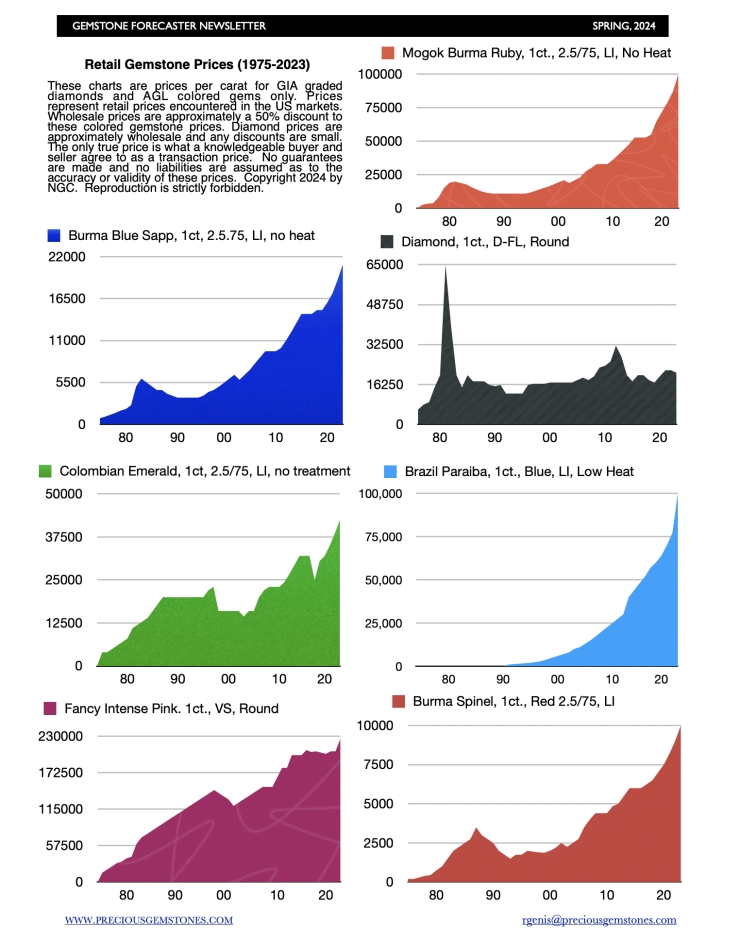
2023 was a year when the top collectible/investment gemstones increased in price and white diamonds got hit hard. The bellwether one carat D-IF was relatively stable falling to $21,000 per carat from $22,000 per carat. Other qualities fell as much as 20%-30%. Colored diamonds increased but not as much as colored gemstones. Vivid and Intense pinks were up 10-12% and Yellow diamonds were up by 4%. Blues only went up an anemic 1.8% with Fancy Intense blues down 4%. The softness in white diamonds is primarily due to the market acceptance of lab grown diamonds (LGD). Lab diamonds now represent over 50% of the market. Because they are so inexpensive, they are driving down the prices of natural diamonds. Millennials have gone "all in" with lab diamonds. If no one can tell the difference, why not buy the lab diamonds and save a few dollars? If you think natural diamonds have gone down, LGD prices are also down about 90% this year. A major LGD producer went bankrupt because of these falling prices.
Burma goods continued their assent as no new goods have been mined or sold in Burma (Burma ruby, Burma sapphire, Burma spinel) in at least four years. We don't expect this to change any time soon.
No-treatment top Colombian emeralds have expanded their niche market with collectors. Clean untreated Colombian emeralds are in strong demand. You see many for sale at the auction houses. Remember, just because a Colombian emerald has a no treatment grading report, it doesn't automatically get a 300%-500% premium if the stone is obviously included. Don't be blinded by the no treatment or slightly treated lab comments. Just like you cannot be slightly pregnant, top emeralds shouldn't be slightly treated.
Just like colored diamonds, the days of buying Brazilian or Mozambique Paraiba Tourmaline under the market are gone. Everyone in the gemstone markets knows these stones are rare and valuable. We never would have thought colored diamonds would sell for over a million dollars per carat. But large ones do every day. Same is true for Brazilian Paraiba. It seems to be every top collector's dream to own at least one of these stones. Price has become almost irrelevant. These electric stones continue their parabolic rise because of incessant demand and no supply. Even the Mozambique Paraiba is closing in on the Brazilian prices.
Finally, Kashmir sapphires sell for 300-500% more than Burma sapphires because they are practically nonexistent. Many hope some new production will be available with a joint venture between the Indian Government and Mineworks of Delhi. Production reportedly begins this summer in May.